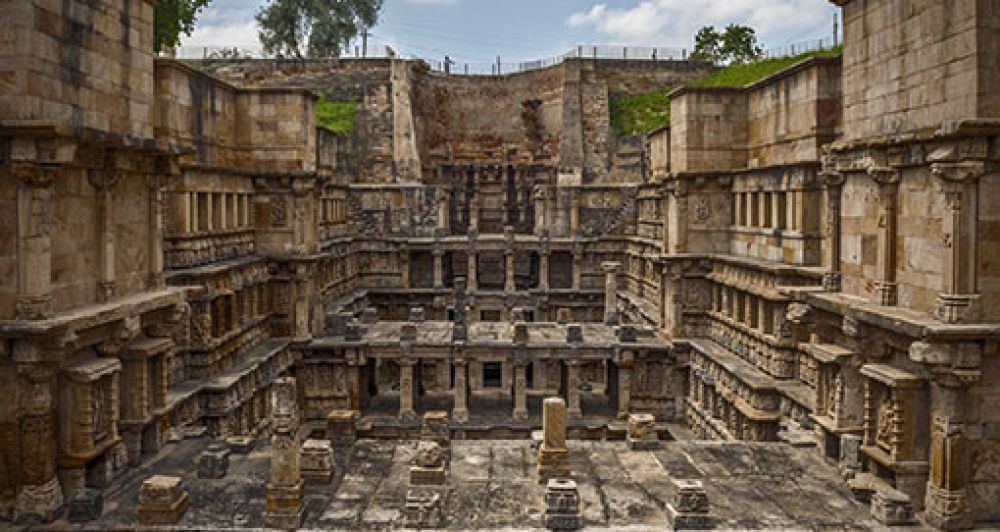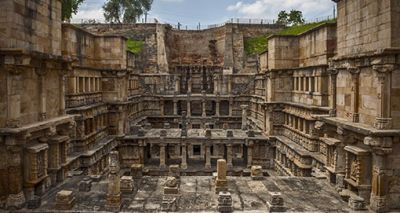

Rani Ki Vav, an intricately constructed stepwell located in Patan, is a UNESCO World Heritage site. This remarkable example of subterranean architecture in Gujarat is a breathtaking sight for visitors. It was built by Queen Udayamati in the 11th century in memory of her husband King Bhimdev I. Throughout the stepwell, one can witness intricate carvings that depict mythological scenes and figures, including avatars of Vishnu, Apsaras, and other divinities. During a guided tour, visitors can learn about the history of the stepwell, the hydraulic engineering marvels of the ancient times, and the significance of the architectural elements found therein. The tour provides a deep dive into medieval Indian culture and the technological advancements existent during that era.
The Patan Patola Heritage Museum offers an insight into the ancient art of Patola weaving, which has been kept alive by the Salvi family in Patan for centuries. The double ikat silk weavings are known for their vibrant colors and intricate designs. Visitors can explore the museum to learn about the intricate process involved in creating Patola sarees, from dyeing the silk threads to the traditional handloom weaving. The history of this craft and its significance to the cultural heritage of Gujarat is well-presented, and one can appreciate the level of skill and dedication required to produce these textiles. Furthermore, witnessing artisans at work is an inspiring experience that conveys the deep roots of craftsmanship in this region.
The Sahastralinga Talav is an ancient artificial water tank in Patan, built by King Siddhraj Jaisinh during the Solanki period. It showcases the advanced hydraulic engineering of the time with an interconnected system of canals and channels for water management. While much of the structure is in ruins today, it still is an imposing historic site, reflecting the grandeur and vision of its builders. Exploring this locale provides an understanding of historical water conservation practices and the complexity of water architecture. As one walks around the ruins, the guides narrate tales of the tank's glory days and King Siddhraj's ambitions for his kingdom, making for an intriguing journey back in time.
Situated near the majestic Rani Ki Vav, the Patan Museum is an important cultural repository that exhibits the history and heritage of the region. Visitors to the museum can view a wide array of artifacts from different eras including, sculptures, coins, inscriptions, and various other antiquities that tell the rich story of Patan's history. The museum itself is housed within a beautifully restored building, wherein each exhibit is well-maintained and curated to provide a comprehensive and educational experience. To fully appreciate the depth of culture and tradition in Patan, one must certainly consider a visit to this museum as it serves as a key to understanding the city's glorious past and artistic expressions.
A visit to Patan would be incomplete without exploring its markets for the authentic Patola sarees, which are a symbol of heritage and elegance. Known for their vivid colors and unique designs, these sarees are a labor of love, taking weavers anywhere from six months to a year to create a single saree due to the complexity of the weaving process. Shopping here offers the chance to meet the artisans behind the looms, understand their craft, and witness the creation of the sarees firsthand. Buying a Patola saree not only gives you a piece of Gujarat's culture but also supports the local artisans who continue to keep this ancient art alive.
Khan Sarovar is a picturesque lake located on the outskirts of Patan and is an ideal place for nature enthusiasts and bird watchers. The lake attracts many migratory as well as local birds, making it an excellent spot for bird watching. With a picturesque setting, visitors can spend hours observing different species of birds, listening to their calls, and enjoying the serene environment. For those interested in photography, the lake offers a perfect backdrop for capturing the striking beauty of winged creatures in their natural habitat. It's always recommended to visit early in the morning, when bird activity is at its peak and the area is less crowded.
While slightly further from the heart of Patan, Sidhpur is home to another magnificent stepwell, reflecting the region's mastery of water architecture. A visit to this stepwell is an excursion that takes one through the history of water storage and religious structures in the area. The stepwell in Sidhpur is less ornate than the likes of Rani Ki Vav but its sheer size and geometrical precision leave visitors in awe. The steps leading down to the water are a mesmerizing sight and offer a peaceful environment to reflect on the ingenuity of ancient civilizations. A guide can help reveal the hidden tales and the architectural significance of this underrated marvel.
Patan is dotted with numerous historic temples, some of which date back to the period of the Solanki dynasty. These temples stand as a testament to the religious fervor and architectural expertise of the ancient inhabitants of the region. Visitors can embark on a temple tour that encompasses various shrines dedicated to different deities such as the Hemachandracharya Jain Gyan Mandir, which also serves as a museum with a collection of ancient manuscripts and Jain relics. Walking through their ancient corridors, one feels transported to a time where devotion and craftsmanship coalesced to create spaces of sublime tranquility and beauty.
The Bindu Sarovar is a sacred tank located in Sidhpur near Patan, known for its religious significance in Hindu rituals for the departed. The Sarovar is believed to be the only place in India where the Matrushraddh ceremony is performed. Pilgrims from all over the country come here to perform rituals for their ancestors. The serenity and spiritual atmosphere of Bindu Sarovar offer visitors a unique sense of peace. The architectural details of the surrounding ghats and temples add to the rich cultural tapestry of the location. A visit here would appeal to those interested in spiritual traditions and looking to experience a piece of eternal India.
Patan is not only famous for its Patola sarees but also for its metalwork, wooden toys, and other handicrafts. Travelers with a keen interest in arts and crafts can participate in workshops conducted by local artisans. These workshops offer hands-on experience in traditional crafts and provide a deeper understanding of the region’s artistry. Participants can get involved in the creation process of various crafts, learn about the tools and materials used, and create their own handmade souvenirs. Engaging with the artisans offers unique stories from their lives and the culture of Patan, making for an enriching and memorable experience.
